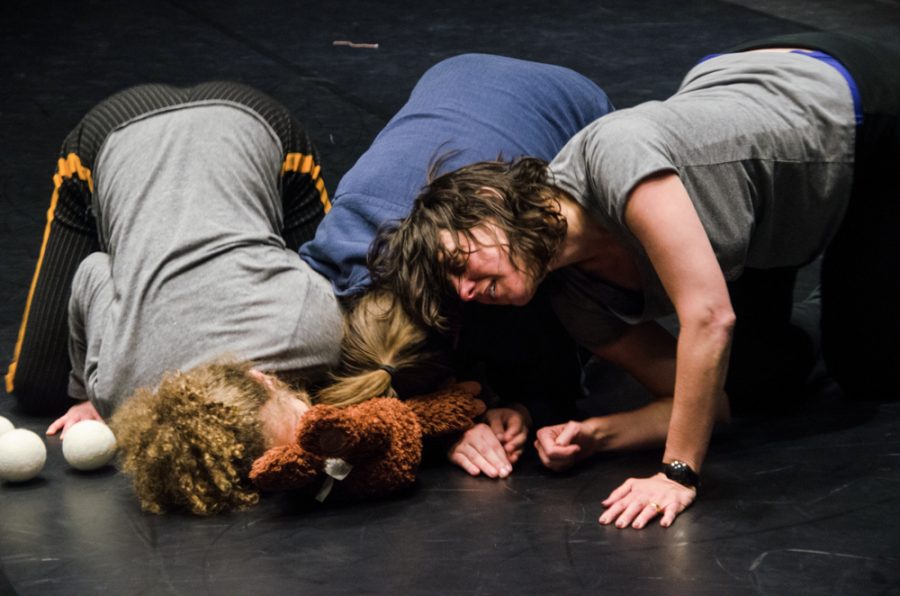Annual Dance Series Features Guest Artists
April 12, 2018
The Spring Studio Dance Series at Harper Joy Theatre has seen a plurality of visiting artists perform. Ranging in theme and subject, the annual series is rapidly becoming a venue for experimental dance and performance. This year, the dance series saw three performances by two solo artists and one collaboration, with one featured on each day of the series running from April 4 through April 7, followed by a faculty-led discussion sessions concerning the dances’ themes and effects.
Assistant Professor of Art History Lisa Uddin, who led a post-performance discussion, had much to say about the importance of the Spring Studio Dance Series.
“I have not experienced art on campus in a way that the Spring Studio Dance Series offered it to me and the Whitman community,” Uddin said. “We have lots of amazing art on campus, but there’s something about the format of the Spring Studio Dance Series that’s unique and makes it a joy.”
Brooklyn-based performance artist Kristopher Pourzal, one of the guest artists who came to Whitman for the dance series, spoke about the central characteristics of his performances.
“My work is interdisciplinary,” Pourzal said. “I feel like people would say that my work has elements of dance and elements of theater, musical elements. There’s definitely a visual art component, as I use a lot of objects. There’s a lot of objects spread around the stage and rearranged.”
Pourzal’s performance, that took place on April 4, was a performance that largely concerned questions of identity. Pourzal hoped that the performance would remind students of the importance of face-to-face interactions.
“At the risk of sounding cliché, in the age of Netflix and social media, more of our days are spent interacting with screens than with other people,” Pourzal said. “Performance is a really powerful and vital return to being together physically, and I think a reminder of how important face to face interaction is. There’s something about the immediacy of performance.”
Pourzal detailed what themes and motifs characterized his work.
“What I would say for my piece here, as well as for my greater work, there’s a real undergirding theme of identities as things that are both concealed and visible,” Pourzal said. “I feel like I’m constantly oscillating between what it is to perform and identity, and live in an identity that’s less visible to the outside world.”
Inspiration for Pourzal’s work can be seen in non-performance art. He listed three artists whose work he cited as inspirational.
“The films and writings of Miranda July,” Pourzal said. “It’s something about how she’s crafting awkwardness, and the bizarreness of mundane and banal human interaction. That really speaks to me. Another person I’ll say is a musician named Anohni. She makes music that’s intensely political, but to pop beats. So it’s this incredible bumping up against of gnarly, political truths and saccharine feel-good bop-your-head beats, that to me is exciting in the way it can trick you into enjoying it despite the brutal truths it’s literally speaking in the lyrics. Kara Walker, a multidisciplinary visual artist. I think this is kind of aspirational for me; she’s very overtly in her work using stereotypes of black people to point to the brutality that is white supremacy throughout history. There are some pretty intense images of violence through her work, pointing to historical violence against women.”
Collaborating artists Heather Kravas, a choreographer, and Victoria Haven, a visual artist, and guests at the Spring Dance Series, were featured on April 7, bringing a unique performance to Whitman with a blending of choreography and visual art.
Haven spoke of the value of bringing their dance to Whitman.
“I feel like they’re [Whitman students] getting the chance to see something that’s very experimental; that in itself has value,” Haven said.
Kravas and Haven also spoke about their unique collaboration and how that has shaped their work.
“We’ve been calling it a durational drawing, somewhere between dance and drawing, that kind of sets the boundaries we’re working within,” Haven said. “We’ve come to this collaboration through years of talking and sharing our practices with each other, and we have certain overlaps in both of our works. For me, with materials, like painting and tape to construct lines, and Heather comes to those ideas with creating lines with bodies in her choreography, and with time.”
“There’s something in this iteration, of overlapping activities, that is of interest currently; a layering,” Kravas said. “Sometimes I think of it like these activities are two worlds coexisting in space at the same time.”
The product of their collaboration was a graphically engaging look at identity.
“I think it’s [the performance is] open to interpretation, as I work with time in a very deliberate way, that is to provide an opportunity for people to have more space in time than they generally get in their daily lives,” Kravas said. “I don’t want people to feel a specific thing, but I hope they would understand that there’s an invitation for them to think about things or feel things at all. I want to provide people with openness, but also to show them that they do have openness.”
All in all, this year’s Spring Studio Dance Series presented Whitman with an opportunity to further its understanding of dance as an art form.






